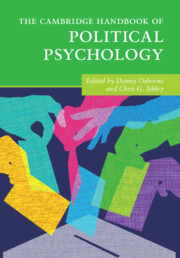Book contents
- The Cambridge Handbook of Political Psychology
- The Cambridge Handbook of Political Psychology
- Copyright page
- Dedication
- Contents
- Figures
- Tables
- Contributors
- Part I Foundations of Political Psychology
- 1 Political Psychology
- 2 The Evolutionary Basis of Political Ideology
- 3 Genetic Contributions to Political Phenomena
- 4 The Psychology and Neuroscience of Partisanship
- 5 The Personality Basis of Political Preferences
- 6 The Structure, Prevalence, and Nature of Mass Belief Systems
- 7 The Psychology of Public Opinion
- 8 Rational Choice and Information Processing
- 9 Emotions and Politics
- 10 The Developmental Science of Politics
- Part II The Politics of Intergroup Attitudes
- Part III Contemporary Challenges to Democracy
- Part IV Diversifying Perspectives in Political Psychology
- Index
- References
8 - Rational Choice and Information Processing
from Part I - Foundations of Political Psychology
Published online by Cambridge University Press: 17 February 2022
- The Cambridge Handbook of Political Psychology
- The Cambridge Handbook of Political Psychology
- Copyright page
- Dedication
- Contents
- Figures
- Tables
- Contributors
- Part I Foundations of Political Psychology
- 1 Political Psychology
- 2 The Evolutionary Basis of Political Ideology
- 3 Genetic Contributions to Political Phenomena
- 4 The Psychology and Neuroscience of Partisanship
- 5 The Personality Basis of Political Preferences
- 6 The Structure, Prevalence, and Nature of Mass Belief Systems
- 7 The Psychology of Public Opinion
- 8 Rational Choice and Information Processing
- 9 Emotions and Politics
- 10 The Developmental Science of Politics
- Part II The Politics of Intergroup Attitudes
- Part III Contemporary Challenges to Democracy
- Part IV Diversifying Perspectives in Political Psychology
- Index
- References
Summary
Rational choice theory explains and evaluates how individuals choose among alternative instruments to achieve their goals and objectives. Although much research on political decision-making highlights psychological biases that appear to interfere with rationality, the contrast between rational choice and the psychology of information processing is often narrowed by individual and contextual conditions that reduce cognitive biases and promote rational decision-making. This argument is developed by analysing research on heuristics (i.e., shortcuts and cues), motivated reasoning, and framing that pose challenges to rational choice. Three themes emerge from this review. First, there is systematic variation across individuals in the extent to which heuristics, biased reasoning, and framing produce unreasonable and suboptimal decisions. Second, there are definable informational and social contexts that provide incentives for people to engage in deliberate and accurate processing of information. Third, normative evaluations of empirical results have been hampered by inconsistent criteria for what constitutes good decision-making.
- Type
- Chapter
- Information
- The Cambridge Handbook of Political Psychology , pp. 118 - 138Publisher: Cambridge University PressPrint publication year: 2022
References
- 1
- Cited by



